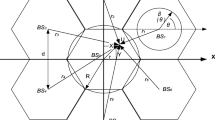Abstract
In the existing Non-Orthogonal Multiple Access power allocation algorithm, the iterative water-filling algorithm is a commonly used algorithm, which has good performance but high complexity. In order to reduce the complexity, this paper divides the power allocation problem of Non-Orthogonal Multiple Access into two steps. Firstly, the water-filling algorithm is used to complete the power allocation between sub-carriers, then the greedy algorithm is used to allocate power to the superimposed users in the carrier. Many elements in the candidate power allocation coefficient set that are impossible to be optimal solutions are deleted by using the sum of power distribution coefficients of each user and the product of throughput, which effectively reducing the complexity. The simulation results show that the proposed algorithm has a slightly lower performance than the iterative water injection algorithm, but it effectively reduces the complexity. The performance of the proposed algorithm is better than other traditional algorithms, and a good compromise between system performance and complexity is achieved.
Access this chapter
Tax calculation will be finalised at checkout
Purchases are for personal use only
Similar content being viewed by others
References
Saito Y, Kishiyama Y, Benjebbour A, Nakamura T, Li A, Higuchi K (2013) Non-orthogonal multiple access (NOMA) for cellular future radio access. In: Proceedings IEEE 77th VTC Spring, pp 1–5
Rec. ITU-R M.2083-0 (2015) IMT Vision—“Framework and overall objectives of the future development of IMT for 2020 and beyond”. http://www.itu.int/rec/R-REC-M.2083
Benjebbour A, Saito Y, Kishiyama Y et al (2013) Concept and practical considerations of non-orthogonal multiple access (NOMA) for future radio access. In: International symposium on intelligent signal processing and communication systems, pp 770–774
Paul M, Haque SME, Chakraborty S (2013) Human detection in surveillance videos and its applications—a review. EURASIP J Adv Signal Process 2013(1):25
Ding Z, Zheng Y, Fan P et al (2014) On the performance of non-orthogonal multiple access in 5G systems with randomly deployed users. IEEE Signal Process Lett 21(12):1501–1505
Wang CL, Chen JY, Chen YJ (2016) Power allocation for a downlink non-orthogonal multiple access system. IEEE Wirel Commun Lett 5(5):532–535
Otao N, Kishiyama Y, Higuchi K (2012) Performance of non-orthogonal access with SIC in cellular downlink using proportional fair-based resource allocation. In: 2012 International symposium on wireless communication systems (ISWCS). IEEE, Paris, France, pp 476–480
Saito Y, Kishiyama Y, Benjebbour A et al (2013) Non-orthogonal multiple access (NOMA) for cellular future radio access. In: 2013 IEEE 77th vehicular technology conference (VTC Spring). IEEE, Dresden, pp 1–5
Xu W (2018) Research on resource allocation algorithm in non-orthogonal multiple access system. Beijing University of Posts and Telecommunications
Liu F, Mahonen P, Petrova M (2015) Proportional fairness-based user pairing and power allocation for non-orthogonal multiple access. In: IEEE PIMRC, pp 1127–1131
Hojeij MR, Farah J, Nour CA et al (2015) Resource allocation in downlink non-orthogonal multiple access (NOMA) for future radio access. In: 2015 IEEE 81st vehicular technology conference (VTC Spring). IEEE, pp 1–6
Jang J, Lee KB, Lee YH (2003) Transmit power and bit allocations for OFDM systems in a fading channel. In: Global telecommunications conference 2003, GLOBECOM’03, vol 2. IEEE, pp 858–862
Acknowledgements
This work was supported by National Natural Science Foundation of China (No. 61271236), Major Projects of Natural Science Research of Jiangsu Provincial Universities (No. 17KJA510004).
Author information
Authors and Affiliations
Corresponding author
Editor information
Editors and Affiliations
Rights and permissions
Copyright information
© 2020 Springer Nature Singapore Pte Ltd.
About this paper
Cite this paper
Lu, Y., Chen, S., Mao, K., Bian, H. (2020). A NOMA Power Allocation Method Based on Greedy Algorithm. In: Liang, Q., Wang, W., Liu, X., Na, Z., Jia, M., Zhang, B. (eds) Communications, Signal Processing, and Systems. CSPS 2019. Lecture Notes in Electrical Engineering, vol 571. Springer, Singapore. https://doi.org/10.1007/978-981-13-9409-6_279
Download citation
DOI: https://doi.org/10.1007/978-981-13-9409-6_279
Published:
Publisher Name: Springer, Singapore
Print ISBN: 978-981-13-9408-9
Online ISBN: 978-981-13-9409-6
eBook Packages: EngineeringEngineering (R0)




